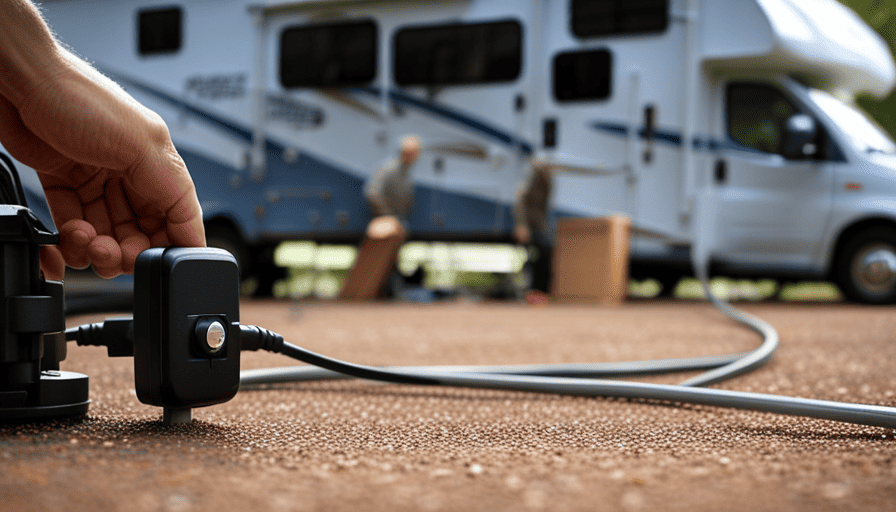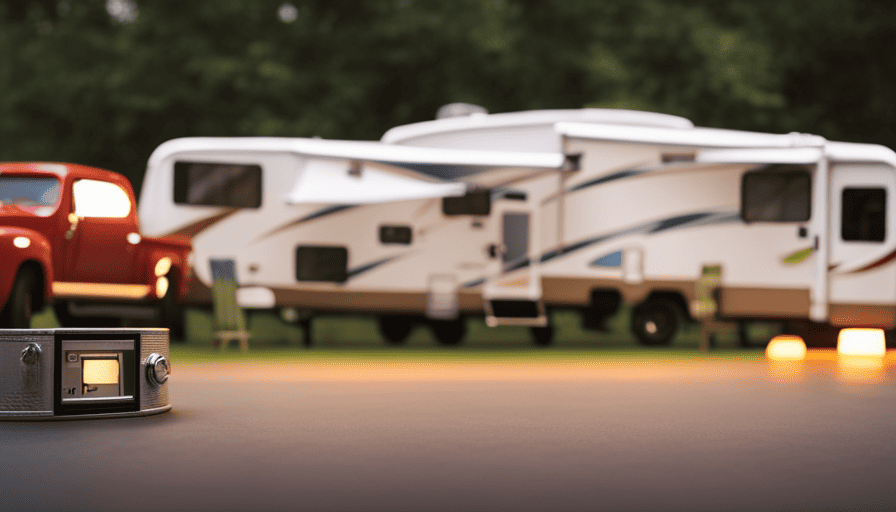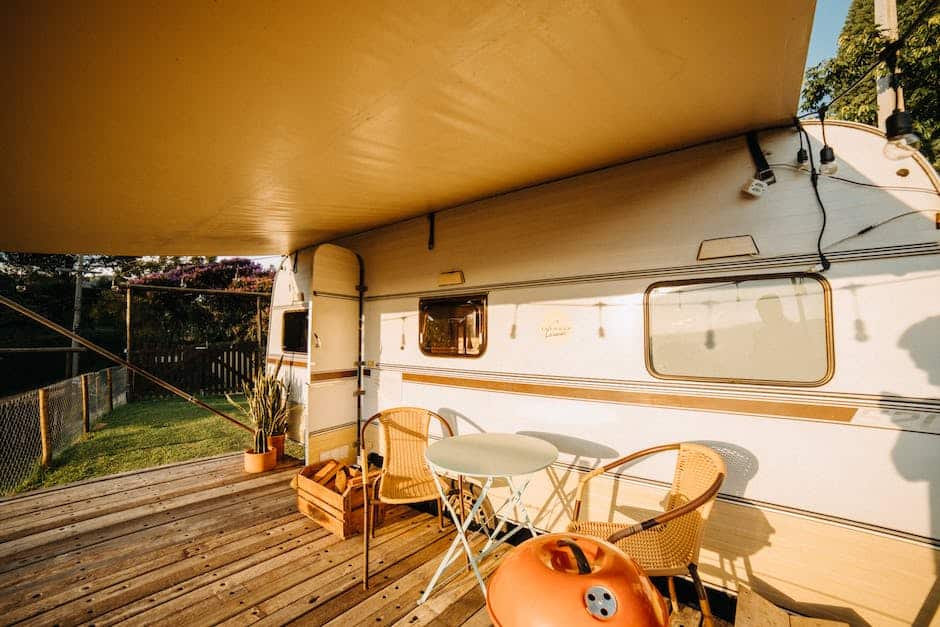Selling a camper that you’re still making payments on might appear challenging, but worry not, fellow camping enthusiasts! We’re here to navigate you through this process with our enlightening and expert advice. In this article, we’re going to give you the essential steps to effectively sell your camper and pay off your remaining loan.
From assessing your loan balance to transferring the title to the buyer, we’ve got you covered. So, let’s embark on this journey together, shall we?
First and foremost, we’ll help you assess your loan balance and determine the market value of your camper. Then, we’ll guide you on how to contact your lender and advertise your camper to potential buyers. Once you’ve found interested parties, we’ll show you how to negotiate the best deal. And don’t worry, we won’t forget about notifying your insurance company, paying off the loan, and obtaining a release of lien.
So, let’s dive in and make sure your camper selling experience is smooth and hassle-free!
Key Takeaways
- Assess loan balance and determine market value of camper before contacting the lender and informing them of your intention to sell.
- Advertise the camper with captivating photos and a compelling description, targeting specific buyer demographics based on the camper’s features.
- Negotiate with potential buyers by conducting market research, emphasizing the value of the camper, being flexible, and knowing your bottom line.
- Complete the sale by fulfilling all necessary paperwork requirements and tasks, including transferring ownership, settling the loan, and notifying the insurance company about the change in ownership.
Assess Your Loan Balance
Before you start dreaming about hitting the open road in your new adventure mobile, take a deep breath and face the reality of your loan balance. Assessing your loan terms and determining the outstanding balance is a crucial first step when figuring out how to sell a camper that you still owe on.
To assess your loan terms, gather all the necessary documents such as your loan agreement, payment history, and any other relevant paperwork. Familiarize yourself with the interest rate, repayment period, and any potential penalties for early repayment. This information will give you a clear understanding of the financial obligations tied to your camper.
Next, determine the outstanding balance on your loan. Contact your lender or check your online account to obtain the most up-to-date information. Be sure to include any accrued interest and fees when calculating the total amount owed.
Once you have assessed your loan balance, you can move on to determining the market value of your camper. This step will help you gauge how much you can potentially sell it for and develop a realistic selling strategy.
Determine the Market Value of Your Camper
First, take a moment to assess the jaw-dropping market value of your beloved home on wheels. Determining the market value of your camper is crucial when selling it, especially if you still owe money on it. To accurately gauge the value, you need to consider two key factors: market demand and research of comparable sales.
Start by researching the current market demand for campers similar to yours. Look online for listings of campers that are similar in make, model, and condition to yours. Take note of their prices and how quickly they are selling. This will give you a good idea of what buyers are willing to pay for a camper like yours.
Next, research comparable sales in your area. Look for campers that have recently sold and are similar to yours in terms of size, age, and features. Take note of their sale prices to get an understanding of the current market value.
By determining market demand and researching comparable sales, you will be better equipped to set a realistic price for your camper. This will attract potential buyers and increase your chances of selling it quickly.
Now that you have determined the market value of your camper, it’s time to move on to the next step: contacting your lender.
Contact Your Lender
Before selling our camper, it’s important to contact our lender and inform them about our intention to sell. This step is crucial as they need to be aware of the changes in ownership and the process of paying off the loan.
We will discuss with them the necessary steps to transfer the ownership and ensure that the loan is fully paid off before finalizing the sale.
Inform your lender about your intention to sell the camper
To ensure a smooth process, we should let our lender know about our plan to sell the camper. This way, we can avoid any unexpected complications along the way. By informing our lender, we can discuss options and potential issues that may arise during the sale.
This step is crucial because it allows us to understand our obligations and responsibilities as borrowers. Additionally, our lender can provide guidance on the process of transferring the ownership and paying off the loan. It’s important to have open communication with our lender throughout this process to ensure transparency and avoid any misunderstandings.
Once we’ve informed our lender about our intention to sell the camper, we can proceed to discuss the process of transferring the ownership and paying off the loan.
Discuss the process of transferring the ownership and paying off the loan
Once you’ve let your lender in on your plans, they can guide you through the process of transferring ownership and settling the outstanding loan, making it as easy as a piece of cake.
Transferring ownership involves a few essential steps. First, you’ll need to locate the necessary paperwork, such as the title and any lien release documents. Then, you’ll need to fill out the appropriate forms with the buyer and submit them to your local Department of Motor Vehicles. This will officially transfer the ownership of the camper to the buyer.
As for the loan payoff, your lender will provide you with the exact amount you need to pay off. This will typically include the remaining balance on the loan, any accrued interest, and any applicable fees.
Once you’ve transferred the ownership and settled the loan, you can move on to advertising your camper to potential buyers, which we’ll discuss in the next section.
Advertise Your Camper
First, take some eye-catching photos of your camper, showcasing its cozy interior and sleek exterior. In order to create compelling advertisements, it’s important to capture the best features of your camper. Highlight the spaciousness of the living area, the comfortable sleeping quarters, and any unique amenities it may have. Pay attention to lighting and angles to ensure that the photos are clear and visually appealing.
When advertising your camper, it’s crucial to target specific buyer demographics. Consider who would be interested in purchasing a used camper and tailor your advertisements accordingly. If your camper is family-friendly, focus on attracting families who enjoy outdoor adventures. If it’s a smaller camper perfect for solo travelers or couples, emphasize the freedom and simplicity it offers.
In addition to the photos, write a compelling description that highlights the key selling points of your camper. Mention any recent renovations or upgrades, the model and year, and any additional features that make it stand out.
By creating captivating advertisements that speak directly to your target market, you will increase your chances of attracting potential buyers who are genuinely interested in your camper. This will set the stage for successful negotiations.
Negotiate with Potential Buyers
When engaging in negotiations with potential buyers, you’ll want to be a skilled navigator, steering the conversation towards a mutually beneficial agreement. Here are four negotiation strategies to help you sell your camper while still owing on it:
-
Research the market: Before negotiating, research the current market value of similar campers. This will help you set a fair price and give you an advantage during negotiations.
-
Highlight the camper’s value: During negotiations, emphasize the unique features and benefits of your camper. Showcase any upgrades or recent maintenance you’ve done to increase its value.
-
Be flexible: Negotiations require compromise. Be open to negotiating on the price, payment terms, or even throwing in some extras like camping gear or a warranty. This flexibility can help close the deal.
-
Know your bottom line: Determine the lowest price you’re willing to accept and stick to it. However, be prepared to walk away if the buyer’s offer doesn’t meet your expectations.
By employing these negotiation strategies and setting a fair price, you can increase your chances of finding the right buyer for your camper.
In the next section, we’ll discuss how to complete the sale smoothly.
Complete the Sale
Now that you’ve successfully negotiated the selling price with potential buyers, it’s time to complete the sale of your camper. This step involves a few important tasks and paperwork requirements that need to be addressed before the transaction can be finalized.
First and foremost, it’s crucial to ensure that all the necessary paperwork is in order. This includes the title of the camper, which should be transferred to the new owner upon completion of the sale. Additionally, you may need to provide a bill of sale, which serves as a legal document confirming the transfer of ownership and outlining the terms of the sale.
Next, it’s important to agree on a method of payment with the buyer. Whether it’s cash, a cashier’s check, or a bank transfer, make sure the payment is secure and verified before handing over the keys to the camper.
Once the payment has been received, it’s essential to promptly pay off the remaining balance on your camper loan. Contact your lender to obtain the necessary instructions and ensure that the payment is processed correctly.
With the sale completed and any outstanding loan balance settled, you can now move on to the next step: notifying your insurance company about the change in ownership.
Notify Your Insurance Company
Once the sale is finalized and your payment is secured, it’s crucial to inform your insurance provider about the change in ownership. This is important to ensure that the new owner is not covered under your policy and to discuss payment and update coverage accordingly.
Notifying your insurance company can help prevent any confusion or potential liability issues in the future. To effectively communicate the change in ownership, follow these steps:
- Contact your insurance provider as soon as possible after the sale is completed.
- Provide them with all the necessary details, such as the name and contact information of the new owner, and the date of the sale.
- Discuss the payment arrangements for any remaining premiums or refunds that may be due.
- Update your coverage to reflect the change in ownership. This may involve removing the camper from your policy or transferring it to the new owner’s policy.
By promptly notifying your insurance company about the sale, you can ensure that the new owner is responsible for obtaining their own coverage. This will also help you avoid any unnecessary expenses or complications.
Once you have updated your insurance coverage, you can proceed to the next step of paying off the loan.
Transition: With the insurance company informed, it’s time to focus on paying off the loan.
Pay Off the Loan
Before selling a camper when you still owe on it, it’s important to pay off the loan.
To do this, we contacted our lender to confirm the final amount that needed to be paid. Once we had this information, we made the necessary arrangements to settle the outstanding debt.
This ensured that we were able to clear the loan and proceed with selling the camper.
Contact your lender to confirm the final amount to be paid
To confirm the final amount to be paid, reach out to your lender and envision the weight lifted off your shoulders as you take the first step towards selling your camper.
Contacting your lender is crucial in this process as they’ll provide you with the necessary information to proceed with selling your camper. They’ll confirm the remaining balance on your loan, including any interest or fees that need to be settled.
This loan confirmation will give you a clear understanding of the exact amount you need to pay off before selling your camper. Once you have this information, you can make the necessary arrangements to settle the outstanding debt and move forward with the selling process.
Taking these initial steps will ensure a smooth transition as you work towards selling your camper and becoming debt-free.
Make the necessary arrangements to settle the outstanding debt
Now it’s time to take the next step and work out the details with your lender to settle the remaining debt. To arrange payment and negotiate a settlement, follow these steps:
-
Contact your lender to discuss your situation and request a payoff amount. This will be the total amount you need to pay to clear the debt on the camper.
-
Determine the payment method that works best for you. You may choose to pay in full or negotiate a payment plan with your lender.
-
Make the necessary arrangements to settle the outstanding debt. This may involve transferring funds electronically, mailing a certified check, or visiting the lender’s office to make the payment.
Once you have settled the debt, you can proceed to the next step of obtaining a release of lien. This document confirms that the debt has been paid and clears any encumbrance on the camper.
Obtain a Release of Lien
Imagine you’re sailing your camper through the sea of financial obligations, and the first step to safely dock your vessel is to obtain a Release of Lien. When you still owe on your camper, there’s likely a lienholder who has a legal claim to the vehicle until the debt is paid off.
To sell your camper, you’ll need to obtain a Release of Lien from the lienholder. This document essentially states that the debt has been satisfied and the lien has been lifted.
The process of obtaining a Release of Lien typically involves contacting the lienholder and requesting the necessary paperwork. They may require you to provide proof that the outstanding debt has been fully paid, such as a bank statement or a letter from your lender. Once you’ve gathered all the required documents, you’ll need to submit them to the lienholder for review.
Once the lienholder approves your request, they will issue a Release of Lien document. This document serves as evidence that the lien has been released and that you have the legal right to sell the camper. With the Release of Lien in hand, you can now move forward with transferring the title to the buyer, ensuring a smooth and legal transaction.
Now that you’ve obtained the Release of Lien, the next step is to transfer the title to the buyer, allowing them to officially take ownership of the camper.
Transfer the Title to the Buyer
Picture yourself as the proud captain of your camper, ready to transfer the title to the eager buyer who’ll soon be setting sail on their own adventures. The next step in selling your camper when you still owe on it is to transfer the title to the buyer.
This process involves officially transferring ownership of the vehicle from you to the new owner.
First, check with your lender to ensure that there aren’t any outstanding liens on the camper. If there’s a lien, you’ll need to obtain a release of lien from the lender before proceeding with the transfer. This document confirms that the loan’s been paid off and that there aren’t any longer any financial obligations tied to the camper.
Once you have the lien release, you can proceed with transferring the title. Contact your local Department of Motor Vehicles (DMV) or similar agency to obtain the necessary paperwork for transferring ownership. This typically includes a bill of sale, the current title, and any other required documents specific to your state.
Complete the paperwork accurately and ensure that both you and the buyer sign all necessary documents. Submit the paperwork to the DMV along with any required fees. The DMV will then process the transfer and issue a new title in the buyer’s name, finalizing the transfer of ownership.
By following these steps, you can successfully transfer the title of your camper to the buyer, ensuring a smooth and legal transaction.
Frequently Asked Questions
What are the steps to assess the loan balance on a camper?
To assess the loan balance on a camper, we first need to gather all the necessary information about the loan. This includes contacting the lender to obtain the current balance, interest rate, and any additional fees that may be applicable.
Once we have this information, we can negotiate a payoff amount with the lender. It’s important to carefully review the terms and conditions of the loan agreement to ensure a smooth transaction.
How can I determine the market value of my camper before selling it?
Determining the market value of your camper before selling it involves going through the appraisal process. This process involves assessing factors such as the year, make, model, condition, mileage, and any additional features of the camper.
It is important to gather information from various sources, such as online marketplaces, dealerships, and similar camper listings. This will help you get a comprehensive understanding of the current market value for your camper, enabling you to set a fair and competitive price when you decide to sell it.
What should I do if I can’t contact my lender?
If you find yourself unable to contact your lender, don’t panic. There are alternative ways to reach out and resolve the issue.
Just like a skilled angler changes their bait when the fish aren’t biting, you too can adapt. Start by researching the lender’s customer service hours and try calling during less busy times.
If that doesn’t work, send a formal letter or email explaining the situation.
Finally, consider seeking assistance from a consumer protection agency or legal counsel if necessary. Remember, persistence and resourcefulness are key when dealing with unresponsive lenders.
Are there any specific tips for advertising a camper to attract potential buyers?
When it comes to advertising a camper to attract potential buyers, there are several tips for effective advertising that can help you sell your camper quickly.
First, make sure to take high-quality photos that showcase the camper’s best features.
Additionally, provide detailed and accurate information about the camper’s condition, specifications, and any additional features or upgrades.
Avoid common mistakes such as using blurry or poorly lit photos, providing incomplete or misleading information, or overpricing the camper.
These tips can greatly increase your chances of attracting interested buyers.
How can I ensure a smooth and legal transfer of the camper’s title to the buyer?
To ensure a smooth and legal transfer of the camper’s title, there are a few key tips to keep in mind. Firstly, both the buyer and seller should agree on a purchase price and draft a written agreement.
Secondly, it’s important to obtain a lien release from the lender if there’s still an outstanding loan on the camper.
Lastly, complete all necessary paperwork, including a bill of sale and transfer of ownership form, and submit them to the appropriate DMV office for processing.
Following these steps will help facilitate a hassle-free transfer of the camper’s title.
Conclusion
In conclusion, selling a camper when you still owe on it can be a complex process. It’s important to assess your loan balance and determine the market value of your camper.
Contacting your lender and advertising your camper are crucial steps in finding potential buyers. Negotiating with interested parties and notifying your insurance company are also essential.
Once the loan is paid off, obtaining a release of lien and transferring the title to the buyer are the final steps. Selling a camper is like navigating a winding road, but with careful planning and attention to detail, you can successfully sell your camper and settle your loan.










